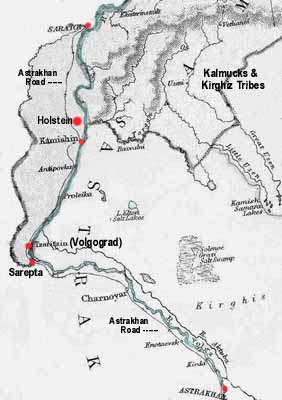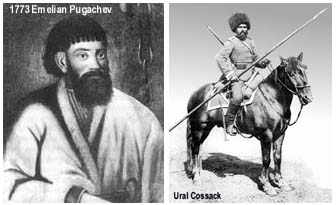 |
 |
| Robber Bands:
In the eighteenth century, boat servants, deserters, vagabonds, and robbers found hiding places along the gorges of the Medveditza, Karamysh and Ilavla rivers, pretty well in the exact region of the later German settlements on the Bergseite side of the Volga. After the founding of the German settlements, the robber economy thrived more and more because the bands now had opportunity for richer booty in their stealing and robbing since the territory was very familiar to them. The robbers were a much worse menace on the Bergseite, rather then theWiesenseite, because the great Astrakhan highway ran through the colonies here and the hilly terrain in some places provided good hiding features. |
 |
 |
| Pugachev:
In the year 1773, a rebel uprising broke out in the middle and lower Volga region under the leadership of the Don Cossack, Emelian Pugachev. He gathered together a huge army of cossacks, serfs, lower class peasants and bandits who eventually brought cruelty and devastation to the newly founded German settlements. All groups of colonies, except perhaps those on the Karaman river, appear to have suffered more or less as the rebel army moved from Saratov to Kamyshin, on the Astakhan road. Pugachev took over the city of Saratov on 6 August, opened the prisons, the grain storage warehouses, the salt depots, tore down the liquor stores, and let his followers plunder the houses. He hanged all the nobility that fell into his hands and forbade their burial. It was probably in Saratov that Pugachev heard for the first time about the German settlers in this region. During his march through the Volga region he came to the colony Norka and demanded a number of wagons to transport the baggage of his army to the next station. As the Pugachev hordes came close to the colonies, everyone made all possible preparations to save family and property from the rebels. With great haste, cellars, sand and clay pits, and even wells were filled with all possible property and covered over with earth. Livestock was driven into the forests or were tied up among the reeds along the river banks. Almost all men and women, even the old people and children, left the village. The rabble following Pugachev not only carried out their customary robberies but also committed murders. Small gangs of agitators and plunderers who split off from the main rebel group, rode or drove around the villages with impunity, to rob and steal. |

| Examples:
On 11 August 1774, Pugachev arrived in the village Donhof (named after the Count) and went to Donhof''s house. The count's wife, ill in bed, was home alone with a two-month-old child. On entering her room, Pugachev ordered the sick woman to leave her bed immediately, knocked her to the floor and took the small child and threw it into a corner of the room. He then searched the bed, stabbing with his dagger, until he realized that no one was hiding there. Then the heartless man ordered the village to be set on fire, beginning with the house of count Donhof. In the colony Kratzke, Pugachev erected gallows and strung up four people. They ransacked the houses, struck old men, women and children with whips, but without killing anyone. By dawn a few houses, including the grainaries, began to burn but fortunately did not spread thus saving much. However the livestock was butchered and taken away with the rebel group. Eventually near Volgograd, Pugachev's fate overtook him and he was defeated
by a Russian general (Michelson), deserted and betrayed by his followers,
captured, and was hung or beheaded in Moscow on 10 January 1775.
|
|
The nomadic Kalmucks, roaming around in the border area of the settlements, never attacked or plundered any colony, but they carried out petty thievery, as opportunity offered. The same was true of Gypsy bands that frequently wandered through the region in the early days. Sometimes nomadic Gypsies or Kalmucks camped near a colony in large numbers, set up their tents, 50 to 100 in number, and wintered there, went about as beggars in the daytime in neighboring places, stole everything that was easy to take, robbed at night items that they had spotted in the daytime. Wherever possible, they drove away the cattle and sometimes even stole children whom their parents never saw again. Kirghiz:
The first attack of the Kirghiz took place in August of the year 1771 and struck two colonies that were the farthest out in the boundary. Most men were out working in the fields when a band of 50 attacked the villages. Because only a few people were at home, the Kirghiz could steal without opposition. However, they were not content with just taking away the livestock and other property, but also made these colonists prisoners in order to sell them into slavery in Bukhara and Khiva. The two colonies came to an end as a result of this Kirghiz attack and those who escaped capture, went to neighboring settlements. The colonies along the Karaman river later had to suffer other attacks. The second Kirghiz attack on the Karaman took place on August 1774 and affected only Mariental . All the livestock and the people, everything that they found, was stolen and carried off across the Ural river into the Russian steppe. The total number of captives taken away from Mariental was about 300, of which very few ever came back. |

| Six German wagons were loaded with bodies from the murder site and
buried in two large graves in the cemetery of Mariental. Missing bodies
were later found on the steppe or in the forest shot with Kirghiz arrows.
The first thing the Kirghiz always did to captured men was search their
pockets for money, then cut all the metal buttons off their jackets.
On 24 October 1774, the Kirghiz attacked the colonies Seelmann, Leitsinger, Keller, and Holzel, and carried away 317 persons into slavery. These people were sold into slavery in minor Bukhara. The total number of German colonists taken captive by the Kirghiz was about 1200, while the number killed in the attacks is unknown. Over the next 25 years some of these captured German colonists returned either by escape or ransom. As a solution, the colonies on the Wiesenseite sent armed patrols to the Ural steppe and developed signals of inflammable material to alarm of impending attack. They formulated strategies of defense, including some government help, which decreased the incursion raids of the Kirghiz. However, it wasn't until 1825 that the fear from these robber tribes finally dissipated. |
|
|